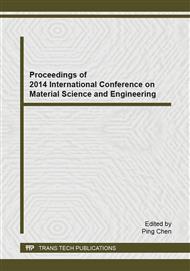[1]
A.K. Geim, K.S. Novoselov, The rise of graphene, Nat Mater, 6 (2007) 183-191.
Google Scholar
[2]
Yuanbo Zhang, YanWen Tan, Horst L. Stormer, P. Kim., Experimental observation of the quantum Hall effect and Berry's phase in graphene, Nature, 438 (2005) 201-204.
DOI: 10.1038/nature04235
Google Scholar
[3]
Jishan Wu, Wojciech Pisula, K. Müllen, Graphenes as potential material for electronics, Chem. Rev., 107 (2007) 718-747.
DOI: 10.1021/cr068010r
Google Scholar
[4]
S.R. Kim, M.K. Parvez, M. Chhowalla, UV-reduction of graphene oxide and its application as an interfacial layer to reduce the back-transport reactions in dye-sensitized solar cells, Chem. Phys. Lett., 483 (2009) 124-127.
DOI: 10.1016/j.cplett.2009.10.066
Google Scholar
[5]
Y.H. Ng, A. Iwase, N.J. Bell, A. Kudo, R. Amal, Semiconductor/reduced graphene oxide nanocomposites derived from photocatalytic reactions, Catal. Today, 164 (2011) 353-357.
DOI: 10.1016/j.cattod.2010.10.090
Google Scholar
[6]
H. Zhang, X. Lv, Y. Li, Y. Wang, J. Li, P25-Graphene Composite as a High Performance Photocatalyst, ACS Nano, 4 (2009) 380-386.
DOI: 10.1021/nn901221k
Google Scholar
[7]
S.S. Bhande, R.S. Mane, A.V. Ghule, S. -H. Han, A bismuth oxide nanoplate-based carbon dioxide gas sensor, Scripta Mater., 65 (2011) 1081-1084.
DOI: 10.1016/j.scriptamat.2011.09.022
Google Scholar
[8]
A. Cabot, A. Marsal, J. Arbiol, J. Morante, Bi2O3 as a selective sensing material for NO detection, Sensors and Actuators B: Chemical, 99 (2004) 74-89.
DOI: 10.1016/j.snb.2003.10.032
Google Scholar
[9]
L. Leontie, M. Caraman, M. Alexe, C. Harnagea, Structural and optical characteristics of bismuth oxide thin films, Surf. Sci., 507 (2002) 480-485.
DOI: 10.1016/s0039-6028(02)01289-x
Google Scholar
[10]
L. Leontie, M. Caraman, M. Delibaş, G. Rusu, Optical properties of bismuth trioxide thin films, Mater. Res. Bull., 36 (2001) 1629-1637.
DOI: 10.1016/s0025-5408(01)00641-9
Google Scholar
[11]
V. Fruth, A. Ianculescu, D. Berger, S. Preda, G. Voicu, E. Tenea, M. Popa, Synthesis, structure and properties of doped Bi2O3, J. Eur. Ceram. Soc., 26 (2006) 3011-3016.
DOI: 10.1016/j.jeurceramsoc.2006.02.019
Google Scholar
[12]
C. Wang, C. Shao, L. Wang, L. Zhang, X. Li, Y. Liu, Electrospinning preparation, characterization and photocatalytic properties of Bi2O3 nanofibers, J. Colloid Interface Sci., 333 (2009) 242-248.
DOI: 10.1016/j.jcis.2008.12.077
Google Scholar
[13]
H. Zhang, P. Wu, Y. Li, L. Liao, Z. Fang, X. Zhong, Preparation of bismuth oxide quantum dots and their photocatalytic activity in a homogeneous system, ChemCatChem, 2 (2010) 1115-1121.
DOI: 10.1002/cctc.201000090
Google Scholar
[14]
T. Gujar, V. Shinde, C. Lokhande, S. -H. Han, Electrosynthesis of Bi2O3 thin films and their use in electrochemical supercapacitors, J. Power Sources, 161 (2006) 1479-1485.
DOI: 10.1016/j.jpowsour.2006.05.036
Google Scholar
[15]
F. -L. Zheng, G. -R. Li, Y. -N. Ou, Z. -L. Wang, C. -Y. Su, Y. -X. Tong, Synthesis of hierarchical rippled Bi2O3 nanobelts for supercapacitor applications, Chem. Commun., 46 (2010) 5021-5023.
DOI: 10.1039/c002126a
Google Scholar
[16]
S.M.F. Shaikh, G. Rahman, R.S. Mane, O. -S. Joo, Bismuth oxide nanoplates-based efficient DSSCs: Influence of ZnO surface passivation layer, Electrochim. Acta, 111 (2013) 593-600.
DOI: 10.1016/j.electacta.2013.08.066
Google Scholar
[17]
N. -R. Chiou, C.M. Lui, J.J. Guan, L.J. Lee, A.J. Epstein, Growth and Alignment of Polyaniline Nanofibres with Superhydrophobic, Nat. Nanotechnol, 2 (2007) 354-357.
DOI: 10.1038/nnano.2007.147
Google Scholar
[18]
N.R. Chiou, A.J. Epstein, Polyaniline Nanofibers Prepared by Dilute Polymerization, Adv. Mater., 17 (2005, 17, 1679–1683) 1679-1683.
DOI: 10.1002/adma.200401000
Google Scholar
[19]
H. -W. Wang, Z. -A. Hu, Y. -Q. Chang, Y. -L. Chen, Z. -Q. Lei, Z. -Y. Zhang, Y. -Y. Yang, Facile solvothermal synthesis of a graphene nanosheet–bismuth oxide composite and its electrochemical characteristics, Electrochim. Acta, 55 (2010).
DOI: 10.1016/j.electacta.2010.08.048
Google Scholar
[20]
Y. Gao, M. Li, Y. Zhang, X. Wang, F. Xu, J. Guo, Preparation of nano-Bi2O3 by high-frequency plasma, Ordnance Mater. Sci. Eng. , 34 (2012) 90-92.
Google Scholar
[21]
YANG YongHui, SUN HongJuan, P. TongJiang, Synthesis and Structural Characterization of Graphene by Oxidation Reduction, Chinese J. Inorg Chem, 26 (2010) 2083-(2090).
Google Scholar
[22]
Z. Ai, Y. Huang, S. Lee, L. Zhang, Monoclinic α-Bi2O3 photocatalyst for efficient removal of gaseous NO and HCHO under visible light irradiation, J. Alloys Compd., 509 (2011) 2044-(2049).
DOI: 10.1016/j.jallcom.2010.10.132
Google Scholar
[23]
X. Lv, J. Zhao, X. Wang, X. Xu, L. Bai, B. Wang, Novel Bi2O3 nanoporous film fabricated by anodic oxidation and its photoelectrochemical performance, J. Solid State Electrochem., 17 (2013) 1215-1219.
DOI: 10.1007/s10008-012-1996-9
Google Scholar



